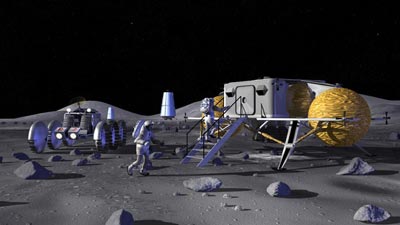NASA and America’s youthby Taylor Dinerman
|
| Quality, not quantity, will create the level of support needed to get back to the Moon and beyond. |
Consider the US Marine Corps. In the middle of an unpopular war, with nothing but pain and hardship to offer, the USMC is recruiting many of the best, brightest, and most dedicated kids in America not by appealing to celebrities but by telling them that they can be part of something that is really important, something that they can feel pride in. Not everyone can be a Marine, and not everyone can be part of the space industry. That message is one that NASA can embrace rather than an amorphous “feel good” one that may promise results in a couple of decades.
Unapologetically leading the human expansion into the solar system is a mission that can inspire a relatively small number of highly dedicated men and women to do great things. Building this future cannot be shaped by methods better suited to selling Paris Hilton’s fragrance or McDonald’s hamburgers. To understand why space colonization is important takes a mental effort that not everyone is prepared to make. One sign of this is the finding by the Dittmar Associates survey that 32 percent of those questioned did not even know that there was such a thing as the International Space Station.
Young people who are informed enough to have an opinion will, over time, be open to the idea that we need the VSE because we need to change the fundamental nature of humanity’s economic system. We need energy and resources from space not just to provide a decent life for the billions of citizens of nations like China and India who aspire to basic middle-class comforts, but to be able to do so in a way that protects the natural environment. Few people are willing to take the time to try and understand these arguments.
The contradiction in NASA’s strategic communications policy over the years is that it has a good story to tell, but it tries to tell it to millions of people who are not prepared to listen. Few young people even know the name of their representative in Congress let alone his or her position on funding the VSE. To try and interest these folks in lunar exploration and settlement is not just a waste of time, it may even generate a hostile reaction.
The whole “NewSpace” phenomenon is changing perceptions of what is possible in space. NASA’s ambiguous relationship with this part of the industry is not helping them reach the kinds of ambitious, hard-charging, smart young people who are naturally attracted to ideas such as space tourism and low-cost rockets. The space agency has done a lot recently to support the new companies and their ideas, but NASA is a government agency and is limited by law and by policy.
| The contradiction in NASA’s strategic communications policy over the years is that it has a good story to tell, but it tries to tell it to millions of people who are not prepared to listen. |
One of the best ideas that the space agency has had is the concept of NASA Academies. Since 1993 this small-scale operation has provided more than three hundred graduate and undergraduate students with a chance to get a close look at what NASA is all about. If the agency really wanted to focus its outreach efforts on young people who could truly have an impact on the future, it would expand this program. If possible, they should also look at developing a similar program for high school students.
The Dittmar Associates survey shows that young Americans do not believe that NASA is “relevant” to their lives. Similar studies would probably show that the Coast Guard or the National Institute of Standards and Technology (NIST) or the Agency for International Development lack relevance as well. The US government’s space program will go forward or not based its real value to the nation, as determined by Congress and the President.
If NASA wants to communicate a simple message about why its mission is essential, why not try something along these lines: in 2050 there will be nine billion humans on this planet, most of whom will aspire to a lifestyle approximating that of a prosperous American today. There is no way that the Earth can provide the resources to support them. Only by going off-Earth for energy and materials can we hope to help the vast majority of humanity obtain a decent standard of living and also protect our environment.
